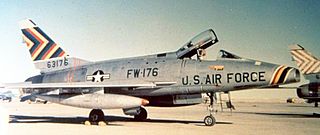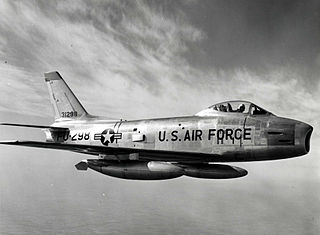
The 44th Air Division, Bombardment was redesignated as a division on 16 April 1948, when it was at Brooks Field, Texas, under the 14th Air Force, then transferred to the 12th Air Force on 1 July 1948.

The 386th Air Expeditionary Wing (386 AEW) is a provisional United States Air Force unit assigned to United States Air Forces Central. As a provisional unit, it may be activated or inactivated at any time. It is currently stationed at Ali Al Salem Air Base, Kuwait in Southwest Asia. During World War II, the group's predecessor unit, the 386th Bombardment Group (Medium) was a B-26 Marauder bombardment group assigned to the Eighth and later Ninth Air Force. During the Battle of Normandy, it supported Allied forces at Caen, and participated in the massive blows against the enemy at Saint-Lô on 25 July 1944. The unit knocked out targets to help clear the Falaise pocket of German forces in August 1944 and hit strong points at Brest during September.

The 322d Air Expeditionary Group is a provisional United States Air Force unit assigned to the United States Air Forces in Europe. As a provisional unit, it may be activated or inactivated at any time.

The 387th Air Expeditionary Group(387 AEG) is a provisional United States Air Force direct reporting unit at Ali Al Salem Air Base, Kuwait under United States Air Forces Central Command (USAFCENT). As a provisional unit, it may be activated or inactivated at any time. In 2016, the groups mission was to provide support for base operations, coordination with host nation partners, and administration of the Joint Expeditionary Tasked individual augmentees in the United States Central Command (USCENTCOM) area of responsibility.

The 114th Fighter Squadron is a unit of the Oregon Air National Guard 173d Fighter Wing located at Kingsley Field Air National Guard Base, Klamath Falls, Oregon. The 114th is equipped with the McDonnell Douglas F-15C Eagle.

The 338th Bombardment Group is a disbanded United States Air Force unit. It was last active with Continental Air Command at O'Hare International Airport, Illinois on 27 June 1949. It was first activated during World War II as the 338th Fighter Group and served primarily as a training unit until it was disbanded in 1944. The group was reconstituted in the reserves in 1947, but was inactivated when military spending was reduced in 1949.

The 490th Missile Squadron is a United States Air Force unit. It is assigned to the 341st Operations Group, stationed at Malmstrom AFB, Montana. The 490 MS is equipped with the LGM-30G Minuteman III Intercontinental ballistic missile, with a mission of nuclear deterrence.

The 386th Tactical Fighter Squadron is an inactive United States Air Force unit. Its last assignment was with the 312th Tactical Fighter Wing, based at Cannon Air Force Base. New Mexico. It was inactivated on 18 February 1959.

The 387th Tactical Fighter Squadron is an inactive United States Air Force unit. Its last assignment was with the 312th Tactical Fighter Wing at Cannon Air Force Base, New Mexico, where it was inactivated on 18 February 1959.

The 303rd Air Expeditionary Group is a provisional United States Air Force unit. In 2011, it was assigned to United States Air Forces Europe to activate or inactivate as needed.

The 388th Electronic Warfare Squadron is an active United States Air Force unit, stationed at Eglin Air Force Base, where it is assigned to the 350th Spectrum Warfare Wing.

The 482d Operations Group is a United States Air Force Reserve unit assigned to the 482d Fighter Wing. It is stationed at Homestead Air Reserve Base, Florida.

The 448th Supply Chain Management Group is an inactive United States Air Force unit. Its last assignment was to the 448th Supply Chain Management Wing at Tinker Air Force Base, Texas, where it was inactivated on 30 June 2010.

The 308th Armament Systems Group is a unit of the United States Air Force's 308th Armament Systems Wing, stationed at Eglin Air Force Base, Florida. The group was first activated at Gowen Field, Idaho as the 308th Bombardment Group. It served as a Consolidated B-24 Liberator unit in the China-Burma-India Theater, where it conducted long range bombing missions against Japanese forces, earning a Distinguished Unit Citation. Following V-J Day, it returned to the United States and was inactivated in January 1946.

The 312th Aeronautical Systems Wing is an inactive United States Air Force unit. It was last active in June 2010 at Wright-Patterson Air Force Base, Ohio, where it managed attack and fighter aircraft systems development as part of the Aeronautical Systems Center.

The 813th Fighter-Bomber Squadron is an inactive United States Air Force unit. Its last assignment was with 482d Fighter-Bomber Group at Dobbins Air Force Base, Georgia.

The 554th Fighter-Bomber Squadron is an inactive United States Air Force unit. It was last assigned to the 386th Fighter-Bomber Group at Bunker Hill Air Force Base, Indiana, where it was inactivated on 8 July 1957.

The 553d Fighter-Bomber Squadron is an inactive United States Air Force unit. It was last assigned to the 386th Fighter-Bomber Group at Bunker Hill Air Force Base, Indiana, where it was inactivated on 8 July 1957.

The 552d Training Squadron is a United States Air Force unit assigned to the 552d Operations Group at Tinker Air Force Base, Oklahoma. The squadron trains aircrew for airborne warning and control missions on the Boeing E-3 Sentry aircraft.

The 323d Expeditionary Operations Group is a provisional United States Air Force unit assigned to the United States Air Forces in Europe. As a provisional unit, it may be activated or inactivated at any time.






























